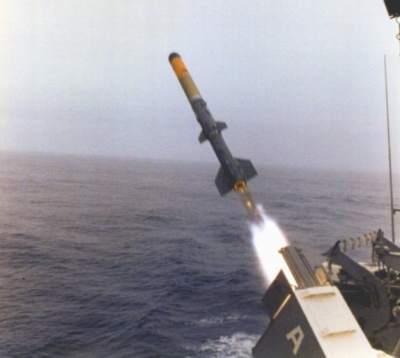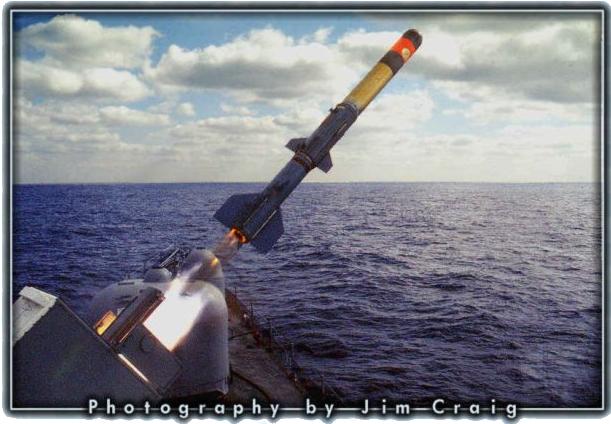Honeywell RUR-5 ASROC
The ASROC (Anti-Submarine Rocket) was the U.S. Navy's main ship-borne standoff anti-submarine weapon from the mid-1950s to the 1980s.
Development of the ASROC began in 1952, when the NOTS (Naval Ordnance Test Station) at China Lake test-fired a rocket-assisted torpedo (MK 24) named RAT 'A'. This was followed by RAT 'B' in 1954 with a larger MK 43 torpedo. However, the two initial RAT designs had unsatisfactory ballistic characteristics and failed to achieve the needed accuracy. Therefore a redesign was started in 1955 under the name RAT 'C'. When this was combined with a requirement for a rocket-boosted nuclear depth charge, the name was changed to ASROC. Honeywell was awarded the development contract in 1956, and ship-borne trials were conducted in 1960. Initial operational capability was finally reached in 1961. On 11 May 1962 a live nuclear-armed ASROC was fired to evaluate to effects of the blast on the launching ship.
ASROC was a very simple weapon. A solid-fuel rocket motor propelled the unguided weapon on a ballistic trajectory, and range was determined by setting a timer before launch. When the timer expired, the motor was separated and the payload continued to fall towards the water. A depth charge simply plunged into the water, while a homing torpedo was equipped with a parachute, which provided the correct angle for entering the water. Payload options of the original ASROC included a W-44 nuclear depth charge (10 kT yield) (designated Rocket Thrown Depth Charge MK 2) and a MK 44 homing torpedo (designated Rocket Assisted Torpedo, later changed to Rocket Thrown Torpedo, MK 3). Most ASROC ships fired the rocket from MK 16 eight-cell "pepperbox" (sometimes called "matchbox") launchers, but MK 26 twin-arm SAM launchers could also be used.
 |
| Photo: David Schmitt via USS Goldsborough Website |
| RUR-5A |
In June 1963, the ASROC was designated as RUR-5A. In 1965 the MK 46 light-weight torpedo replaced the MK 44 as the conventional ASROC payload. The ASROC with MK 46 was known as Rocket Thrown Torpedo MK 4. Except for minor modifications, like a new motor separation unit for improved reliability and accuracy, the weapon remained essentially unchanged. In 1987, the U.S. Navy allocated the designations RUR-5B, RUR-5C, RUR-5D, and RUR-5E to "improved RUR-5A" weapons. I don't know the specifics of these improvements, but it's possible that the different designations were allocated to differentiate between ASROCs with different payloads. In September 1989, at the end of the Cold War, the nuclear capability of ASROC was removed.
 |
| Photo: Jim Craig |
| RUR-5A |
In the early 1990s, the designation RUR-5F was assigned to ASROCs modified to use new safety assemblies and shielded cable assemblies. The designation RTR-5F referred to an inert non-flying round for ground handling training. By that time, phase-out of the RUR-5 had already begun, and by 2000 almost all RUR-5 rockets had been replaced by the RUM-139 VL-ASROC (Vertical Launch ASROC), which is essentially an ASROC modified for launch in the MK 41 VLS (Vertical Launch System). Total production of the RUR-5 was more than 1000 rockets.
Specifications
Note: Data given by several sources show slight variations. Figures given below may therefore be inaccurate!
Data for RUR-5A (MK 46 torpedo payload):
| Length | 4.50 m (14 ft 9.4 in) |
| Finspan | 0.84 m (2 ft 9.25 in) |
| Diameter | 0.34 m (13.25 in) |
| Weight | 486 kg (1072 lb) |
| Speed | Mach 1 |
| Range | 820 m - 16 km (900 yds - 10 miles) |
| Propulsion | Solid-fueled rocket motor |
| Warhead | 45 kg (100 lb) HE in MK 46 torpedo |
Main Sources
[1] Norman Friedman: "US Naval Weapons", Conway Maritime Press, 1983
[2] Norman Friedman: "World Naval Weapons Systems, 1997/98", Naval Institute Press, 1997
[3] James N. Gibson: "Nuclear Weapons of the United States", Schiffer Publishing Ltd, 1996
[4] Bill Gunston: "The Illustrated Encyclopedia of Rockets and Missiles", Salamander Books Ltd, 1979
Back to Current Designations Of U.S. Unmanned Military Aerospace Vehicles
Back to Directory of U.S. Military Rockets and Missiles
Last Updated: 18 July 2005